Wind Energy Evolution And Expectations: A typical case of gigantism.
Editor | On 09, Jan 2004
1. Introduction
A technological system evolves through periods of infancy, growth, maturity and deline. Figure

Let’s compare the different renewable energies (and their S-curve), which are formed by:
-Hydraulic energy. (Old Age period)
-Wind energy. (Growth period)
-Solar energy. (Infancy period)
-Geothermal energy. (Infancy period)
-Biomass energy. (Infancy period)
-Others…
The wind and hydraulic energies have passed the infancy period. But the hydraulic is actually in his aging period. So in this chapter we will talk only about wind energy. Around 2% of solar energy that reaches to the earth from the sun is transformed into wind energy. So this is a great amount of energy. In this article we will talk about the wind genertators as a system.
The wind energy produced during last 30 years has been growing in a spectacular rate.Actually it is concentrated in only 10 countries around the world:

From the total of 17.260 installed MW (Megawatts) in 2001 Around 12.620 MW are installed in the European countries (Germany 35%, Spain 13,1%, Denmark 13%). The first wind turbines (produced in mass process) were installed in the 70´s in Denmark and they had less than 50 kW per unit. Nowadays the biggest have 1,5- 4 MW per unit (a growth of 100x). But as we should see in chapter 3 this system (wind generators) will reach to its maximum power per unit in a few years. This is a typical case of gigantism. So we can see how important is the Wind Energy in the electric power systems. We will try to utilize the application of TRIZ instruments supports as Technology Foresight in this case for forecasting of the Wind Energy Systems (wind generators).
2. Forecasting with TRIZ
The aim of utilizing TRIZ for forecasting is to anticipate the future changes in the technology area and trying to define the next changes that will appear in the near future.We can see the systems and subsystems including in a typical Wind Farm:

In a typical wind farm the mechanic energy produced by the wind generator is transferred to the transmission networks and this to the electric station which evacuates Europe 12.620 73,1% USA 2.249 13,0% India 1.149 6,7% China 300 1,7% Japan 145 0,8% Others 796 4,6% the energy to the power line. A wind farm is also a subsystem of the electric power system.
2.1 History of the wind energy 1888-1980. Infancy period. Charles F. Brush (1849-1929) is one of the founders of the American electrical industry. His company, Brush Electric in Cleveland, Ohio, was sold in 1889 and in 1892 it was merged with Edison General Electric Company under the name General Electric Company (GE). During the winter of 1887-88 Brush built what is today believed to be the first automatically operating wind turbine for electricity generation (Figure 2).

It was a giant – the World’s largest – with a rotor diameter of 17 m (50 ft.) and 144 rotor blades made of cedar wood. The turbine ran for 20 years and charged the batteries in the cellar of his mansion. Despite the size of the turbine, the generator was only a 12 kW model, the weight of the tower is 36 Tons (80,000 pounds). With a total of 0,25 kW per Ton. Several years later Poul la Cour (1846-1908) who was originally trained as a meteorologist was the pioneer of modern electricity generating wind turbines. His association (Society of Wind Electricians) worked on turbines typically of a size from 20 to 35 kW installed power (Figure 3) .
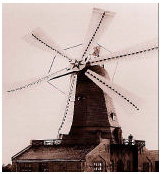
The Smidth machine (Figure 4), built in 1942, was a typical “Danish” machine. It was part of a wind-diesel system, which ran the electricity supply on the island. In 1951 the DC generator was replaced with a 35 kW asynchronous (Alternating current) generator, thus becoming the second wind turbine to generate AC.
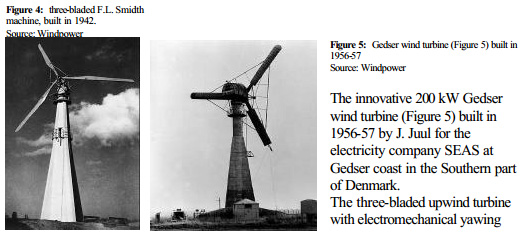

2.2 History of the wind energy since 1980. Growth period.
The 55 kW generation of wind turbines which were developed in 1980 – 1981 became the industrial and technological breakthrough for modern wind turbines. The cost per kilowatt hour (kWh) of electricity dropped by about 50 per cent with the appearance of this generation of wind turbines. Actually there are many turbines with a power of more than 1.000 kW (1 MW). For example the 2.000kW Gamesa G80 (Vestas prototype). It has a weight of approximately 222 Tons.
2.3. Increasing the Ideality throw the history
“The main law of technology evolution: all systems evolve towards the increase of degree of ideality. An ideal technical system is a system that does not exit buts its function is delivered.†( Page 141 of “TRIZ: The Right Solution at the Right Time†, Yuri Salamatov ) So we have to define the Ideality for this System (Wind Generator):
![]()
· Useful Functions:
-Electric Energy production (Main useful function)
-Continuity of production
-Simplicity of construction
….
· Harmful Functions + Costs:
-Costs of fabrication (mass of the system), transport and installation.
-Noise.
….
So if we don’t take care about the secondary functions (useful or harmful) like
continuity or noise, we can approximate the Ideality as:

So after this point we will use the ratio kW/ Ton. We can see (Figure 7) the increase of Ideality since 1888 (Brush’s system has an Ideality ˜ 0,25 kW/Ton) until nowadays (Gamesa´s G-80 has an Ideality ˜ 9 kW/Ton) (Figure 7). We must compare this graphic with the TRIZ base line (Figure 8) and we can realize of the actual point:
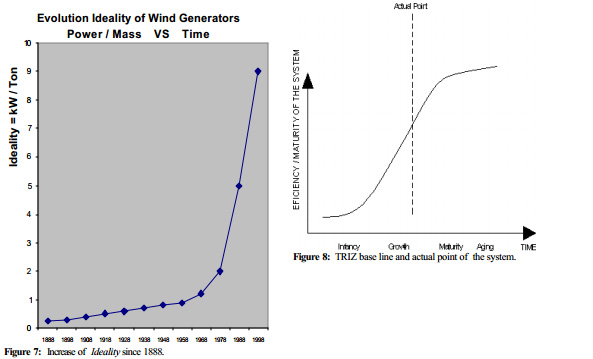
Also we can compare the case data about benefits and the TRIZ base line. Here is too difficult to know the annual benefits of all companies around the world. So we will use the world’s installed power (Figure 9) per year during last 20 years:

3. Ideal Final Result. Typical case of gigantism
Altshuller defined the IFR as “…a fantasy, a dream. It can not be reached, b ut it will allow us to build a path to the solution…â€. So we will try to reach to the highest develop of the system towards imagining the IFR. In this system the ideal system is one witch perform its ability to catch the energy of the wind without existing. The main problem of the new (large) turbines is that the companies try to work in the same way as they did for constructing the oldest (small) turbines. Here is an example of possible evolution of the system. The Figure 11 shows the actual position of the system technology:
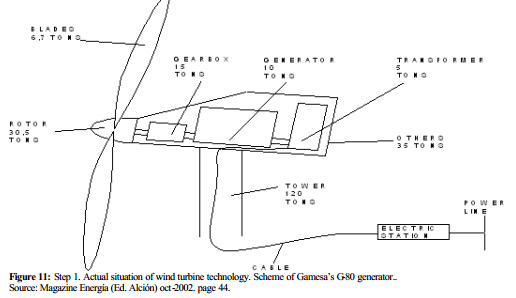
This system has a total mass of 222 Tons (excluding foundations) and a power of 2.000 kW, so the Ideality Ëœ 9 kW/Ton, as we defined the ideality before. This is a typical case of gigantism. “The absurd gigantism in engineering is the result of a barefaced approach to the problem of the main useful function increase: the designers try to increase power as well as resources and energy consumption instead of introducing new principles and inventive solutions. That is why the technical systems of this kind reach their objective limits so very quickly.†( Page 148 of “TRIZ: The Right Solution at the Right Timeâ€, Yuri Salamatov). Actually we are reaching to this limit, as we can see in the Figure 12:
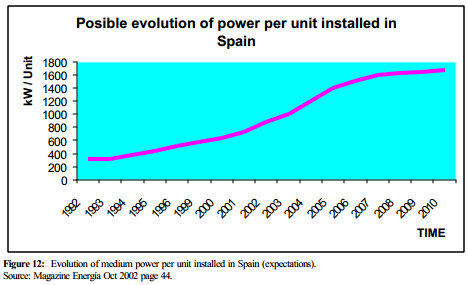
years, so if we want to improve the system we should decrease the cost (mass+others) and other harmful functions rather than construing bigger systems. So lets take a look at the IFR (Ideal Final Result). As the Ideal Final Result says: “One of the elements of the system or environment eliminates a detrimental (superfluous, redundant) effect preserving the capacity to produce a useful effect all by itself. “( Page 155 of “TRIZ: The Right Solution at the Right Timeâ€, Yuri Salamatov). So in the next step we eliminate the Gearbox witch is the heaviest subsystem and bring its useful effect to another element (Generator). This is actually proposed by an study of the University of Navarra (Spain). This study also improves the mass of the blades with a decrease of the mass of the rotor and tower (Figure 12).
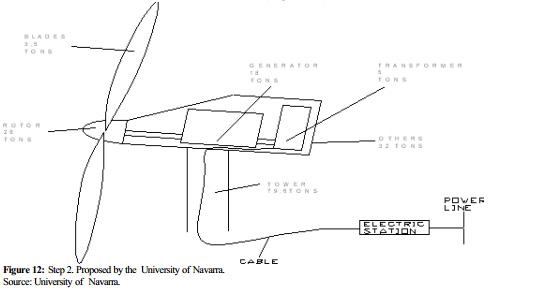
Continuing with this strategy (Ideal Final Result) the next step is to eliminate the Transformer and bring its useful effect to another element (Generator) and to a part of the supersystem (electric station). This is proposed by WINFORMER®, decreasing also the mass of the rotor and tower (Figure 13). In this case an DC-AC converter is needed in the electric station. But in this study we only take care about the system (Wind Generator).
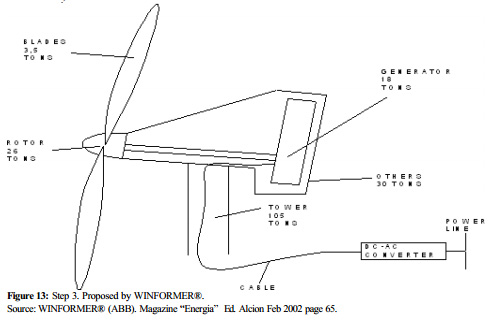
This system has a total mass of 149 Tons (excluding foundations) and a power of 2.000 kW, so the Ideality ˜ 13,3 kW/Ton, with an increase of 11,5 %. If we want to increase its ideality we must try to eliminate the Generator and bring its useful effect to another element (Blades) in the next step (Step 4) . So in this case the mass of the tower lowers (Figure 14) increasing the Ideality . So the main useful function of the generator (the generation of electric energy) is given to the blades by putting in the blades the windings and other elements of the electric generator. So no generator is needed but its function is delivered (Ideal Final Result).

This system has a total mass of 75 Tons (excluding foundations) and a power of 2.000 kW, so the Ideality ˜27 kW/Ton, with an increase of 48%. We actually are in a non-return point in which the Ideality of the system increases and increases. As the theory of evolution says, the last step is the only use of fields. So the next step (Try to imagine the IFR), could be something like this (Figure 16):
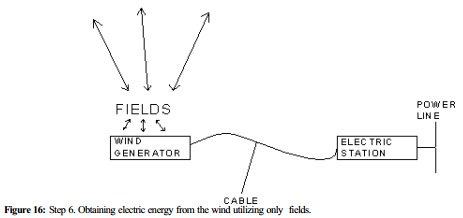
4. Conclusions.
It could seem that the approximation (Ideality ˜ Power/mass) that we have done in the
2.3 point is quite rare, but this is a workable approximation because we can compare different systems and technologies.
How long we will see the actual generators in our countries?. This is a very difficult question. The next generation will not come until this generation will not fall down. This will not occur until 2010 (Kioto´s protocols), because most of countries are actually giving money help to renewable energies. This money will act in an antimodernization. But is supposed that when more profitability will be needed then the new generators will appea

